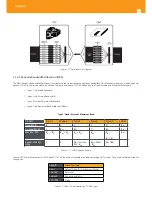
EN
17
PON RF video overlay service is the way to deliver a broadcast TV service over a PON fiber network. This video overlay service is foreseen to provide
mainly broadcast video transmission in contrast to unicast and/or multicast IP video transmission which is used for IPTV and/or Video-On-Demand
having the need for a Set-Top-Box or a Smart TV at the customer premises.
Standardization bodies (ITU for GPON and IEEE for GEPON) have excluded the use of the 1550 -1560nm wavelength window for IP transmission on
PONs and have even continued with this approach for the upcoming 10GPON and 10GEPON standards. The 1550-1560nm wavelength window
is thus exclusively reserved for the video overlay transmission and by that mean an option to offload unicast and/or multicast video transmission
from the IP PON transmission link.
Typically an extra fiber testing signal (1650nm) for optical network probing is also added to the PON optical communication link.
2.11 Voice
Refs. 769501-769502 voice service provisioning could be made through OLT configurations over OMCI messages or could be downloaded (FTP)
from the OLT up to the Refs. 769501-769502 after the Refs. 769501-769502 registration on the PON network. The Refs. 769501-769502 gateway
family equipments have the ability to deliver the Voice service over two types of interface:
Logical interface (VLAN encapsulation)
If the Refs. 769501-769502 has no FXS ports and the VoIP service is transparently forwarded from the OLT up to the Home Gateway (and vice versa)
within a previously defined voice VLAN. Refs. 769501-769502 respects the defined priority and implements the traffic encapsulation from its own
Ethernet interface into a specific T-CONT/GEM-Port over the PON interface and up to the OLT equipment.
Physical interface (FXS ports)
The Refs. 769501-769502 has physical RJ11 FXS interfaces. In this version of the Refs. 769501-769502 equipment, voice interfaces are terminated in
the equipment by means of FXS (RJ11) connections. The RJ11 analog terminals adapter function is auto/self-configured, integrated (analog/VoIP)
and associated with a defined SIP or Megaco (H.248) user.
The Refs. 769501-769502 will allow VoIP or NGN (Next Generation Network) traffic from devices connected to the RJ11 or RJ45 interfaces, towards
the same internal VLAN.
Apart of the SIP and Megaco (H.248) self-configuration, it is also possible to make modifications in the voice service configurations by updating
the Refs. 769501-769502 SW through download from the OLT via OMCI.
The Refs. 769501-769502 equipment has a DHCP client to get an IP address, alternatively the Refs. 769501-769502 could be configured with a
static IP. The configuration of the static IP or DHCP client is related to the WAN side and is enabled by the OLT.
2.12 WI-FI
2.12.1 Operational description
The Refs. 769501-769502 supports WI-FI, with an WI-FI interface currently operating in the 2.4GHz frequency.
The Refs. 769501-769502 complies with the following standards:
IEEE 802.11b (2.4GHz, 11 to 22 Mbps)
IEEE 802.11g (2.4Ghz, up 54 Mbps)
IEEE 802.11n (MIMO-OFDM 2.4GHz, 65Mbps to 300Mbps)
The ONT supports the following wireless security features:
WEP encryption (64/128 bits)
WPA (Wireless Protect Access) TKIP
WPA2 AES
Содержание 769501
Страница 1: ...GPON ONT OFFICE GPON ONT HOME EN Ref 769501 User s Manual w w w t e l e v e s c o m Ref 769502...
Страница 2: ......
Страница 60: ...60 GPON ONT Figure 5 39 Advanced Setup routing current routing table...
Страница 61: ...EN 61 Figure 5 40 Advanced Setup DNS current DNS server table...
Страница 83: ...EN 83 1 2 3 4 5 6 Figure 5 78 Advanced Setup LAN IPv6 VLAN Auto Configuration window...
Страница 196: ......
















































